20 to 22 Sep, 2024 - Paro, Taktshang Goemba, Chele La - (Bhutan)
Kuzuzangpo La. A common greeting, in Dzongka. "Kuzuzangpo" means good health or well-being. Adding "la" at the end shows respect and politeness. We have taken days to master this. Equally useful, and just as much of a mouthful, "Kadrinchey la". Thank you. By day five, we were starting to use the two phrases comfortably, but not always quickly. There was a risk that we would be standing on a doorstep, racking our brains for a minute, only to blurt out "thank you" as we stepped in to a restaurant, smiling at the staff and diners.
As our time in Bhutan nears its end, we head back to Paro, a little west of Thimphu. This is where the airport is located, but it is the most convenient place to stay when visiting Taktshang Goemba, the Tigers Nest. Undoubtedly, the site is what I have been waiting for the most on this trip, and the first photos I saw of this many years ago awoke in me a desire to come to Bhutan. Guru Rimpoche is credited with bringing Bhuddism to Bhutan, and he is said to have flown on a tiger to this site where he battled and defeated a demon. He then stayed in a cave for 3 years, 3 months, 3 weeks, 3 days, and 3 hours. It is now one of Bhutan's most holy places.
Although much of the monastery was destroyed by a devastating fire in 1998, the restoration and rebuild was true and faithful to the original. The king had ordered that it should reproduce as accurately as possible, not just style and building materials, but even using original building methods as possible.
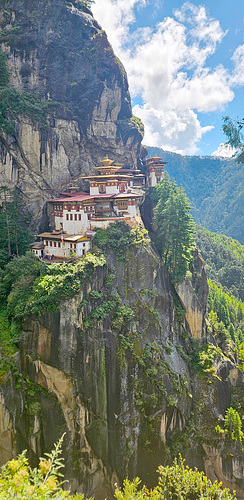
Taktshang Goemba - the Tiger's Nest
Perched high above Paro, the climb to this monastery was obviously rewarding.
From this viewpoint, it felt tangibly close. We had ascended for nearly 2 hours, climbing somewhere between 500 and 600 metres.
But, it was not over. To get "from here to there", we had to descend and re-ascend again, adding perhaps another 100 metres of work.
Entry to the monastery is by ticket. The ticket office is at the start of the walk. You don't really want to forget that!
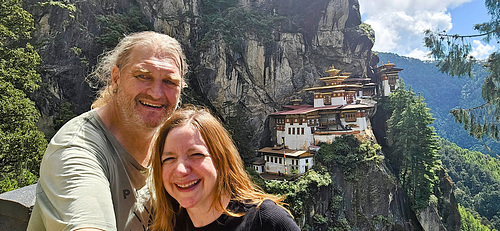
Selfie, Opposite the Tiger's Nest
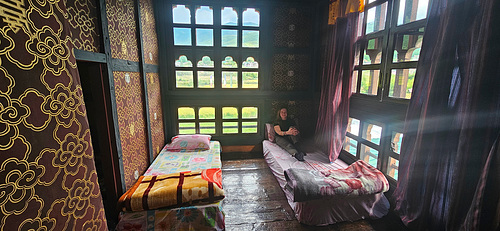
Farm Stay Accommodation
Near Paro, we stayed at the "Tsherring Farmhouse".
Our main reason for choosing it was the on-site hot stone baths. But we did want the local experience.
The main building, besides being a temple, had a variety of rooms round the outside. Nothing fancy, but this was our little nook.
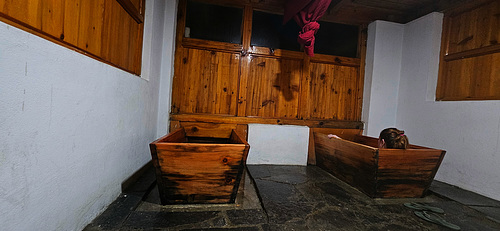
Unwinding in Hot Stone Baths
There are rooms of varying size, with one, two, or more baths. We were in room 5. The baths were ready for us, with herbal sprigs floating in them, and steaming indications of hot water.
We lowered ourselves in, and let the hot water perform its rejuvinating magic. As the water cooled, we would knock on the wooden panels. Moments later, a voice would call from the other side - "Stone?" "Yes please", we'd respond. And within a minute we would feel the thunk of large hot stones being dropped in the water of our baths.
So the ends of our baths stick out through the wall, and are well divided from where we sit, and where the stones are dropped, so as to not risk our feet touching the stones directly.
The stones are piled over a fire, and large metal tongs are used to move them about. Two or three men were servicing the baths, cleaning and preparing, or adding stones.
It was an amazing experience.
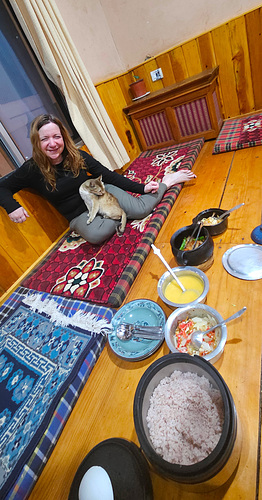
Farmhouse Dinner
Every ingredient, bar the meat, was from the farm.
The little kitten would not take no for an answer. A lap was her one intention, and discouragement was pointless.
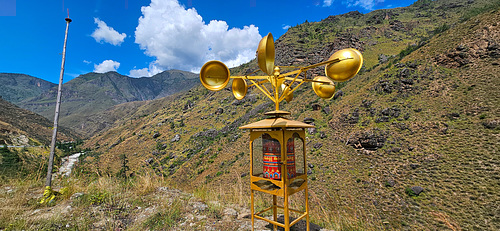
Wind Powered Prayer Wheel
Roadside. It was not even a very windy day, and it had quite a pace.
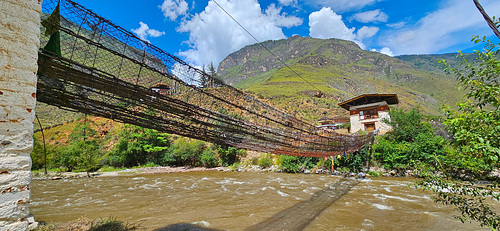
Bridge at Tamchog Lakhang
Thangtong Gyalpo, hailing from Tibet, built iron chain bridges through Tibet, Bhutan, and elsewhere in the Himalayas, in the 15th century. He is now known as Lama Chakzampa, or Iron Bridge Lama. The last surviving of the 600 year old bridges in Bhutan was washed away by floods in 2004.
This is a recreation, using a lot of pieces from the original bridge.
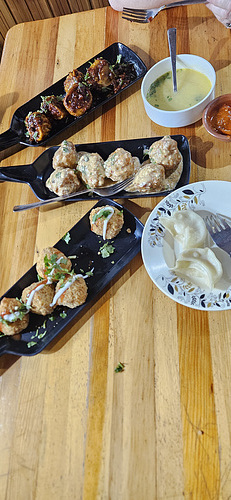
Mo' momos?
In Paro, we found this little place with 3 or 4 tables, although seemingly doing quite a take away trade as well. Just momos. All sorts of momos.
Here, we have, top to bottom:
- chilli momos;
- tandoori momos;
- crumbed and fried momos (by a name I don't remember); and
- cheese momos.
The kitchen was about 3 square metres. There was one lady seated, just rolling out momo skins to be filled. A chef out back who we could only make out by shape as the shadow darted back and forth. And another two running around to take and fill orders.
It was delightful, and we had food from here twice. The first time, I took takeaway back to the hotel room, and it was so good, we knew our final Bhutan dinner had to be a momo feast.





























